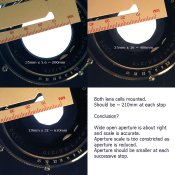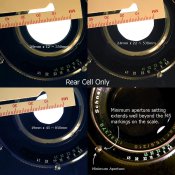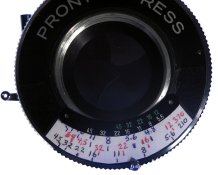User Removed
Member
- Joined
- Sep 29, 2004
- Messages
- 1,296
- Format
- Plastic Cameras
I'm having abit of problem here trying to figure this out. I just picked up a Perigraphic Convertible Gundlach 11x14 lens, 16", 25", 34". Its a barrel lens, but came with a special adapter ring to mount each element into a copal #3 shutter. Here are the following F/stop scales for each different focal length
16" (both elements together) 5.6, 8, 11, 16, 22, 32, 45, 64.
25" (Rear element only) 11, 16, 22, 32, 45, 64.
34" (Front element only) 16, 22, 32, 45, 64.
I have a Copal #3 F9, which has the scale of 9, 11, 16, 22, 32, 45, 64, 90, 128.
I want to be able to screw the 34" (f/16) into my F/9 copal 3 shutter. When doing so, I have the f/16 lens in a f/9 shutter...what F/stop is it really?
Same thing if I screw the 35" (f/11) into my f/9 shutter...what would it really be at?
How can I figure out what F/stop's scale match up with each element of the lens in this shutter?
I tired all lens elements in the copal #3 shutter and all focus correctly and cover my 11x14 camera very well. I am shooting with just the lens element in the shutter...not the extra barrel with the aperture scales.
Thanks so much for your help!
16" (both elements together) 5.6, 8, 11, 16, 22, 32, 45, 64.
25" (Rear element only) 11, 16, 22, 32, 45, 64.
34" (Front element only) 16, 22, 32, 45, 64.
I have a Copal #3 F9, which has the scale of 9, 11, 16, 22, 32, 45, 64, 90, 128.
I want to be able to screw the 34" (f/16) into my F/9 copal 3 shutter. When doing so, I have the f/16 lens in a f/9 shutter...what F/stop is it really?
Same thing if I screw the 35" (f/11) into my f/9 shutter...what would it really be at?
How can I figure out what F/stop's scale match up with each element of the lens in this shutter?
I tired all lens elements in the copal #3 shutter and all focus correctly and cover my 11x14 camera very well. I am shooting with just the lens element in the shutter...not the extra barrel with the aperture scales.
Thanks so much for your help!






